
Slow loris welfare and conservation
For this Fall, 2018 Hot Topics feature, we interview Dr. Anna Nekaris about how conservation and welfare issues intersect in her work with slow lorises (Nycticebus spp.). Dr. Nekaris is a Professor of Anthropology and Primate Conservation at Oxford Brookes University in the United Kingdom. She is the founder and Director of the Little Fireface Project (LFP), which aims to save the slow loris through ecology, education, and empowerment. Research by Dr. Nekaris and her students has revealed fascinating details about the ecology of the world’s only venomous primate, which is increasingly imperiled by the illegal wildlife trade. More information can be found on the LFP YouTube Channel, including this video on why slow lorises should not be kept as pets.
ASP: What is the Little Fireface Project (LFP)?
Anna: LFP is a project under the auspices of the Nocturnal Primate Research Group in the Faculty of Humanities and Social Sciences at Oxford Brookes University. This group started in the 1990s by Professor Simon Bearder to develop a strong coalition of people working on conservation and ecology of nocturnal primates. LFP is one project, largely focused on slow and slender lorises, but over time, we have worked on many obscure nocturnal species that are often forgotten including small cats, other small carnivores, owls, and colugos. Over the years we have worked in India, Sri Lanka, Cambodia, Thailand, and various parts of Indonesia. Now our fieldwork is largely focused on the island of Java, where, in 2011, we instigated the first long-term study of any Asian loris. We are continually monitoring individuals by radio tracking, as well as engaging in community empowerment, education programs, and training of national wildlife protection staff. Finally, we use our platform to engage in international awareness that slow lorises should not be pets; this includes use of social media, as well as training sessions around the world.
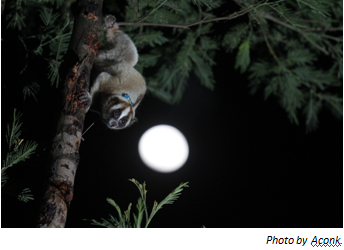

ASP: We know that the illegal wildlife trade is having a major impact on the conservation status of slow lorises. Will you tell us how the illegal wildlife trade affects slow loris welfare?
Anna: Illegal trade affects slow loris welfare in many ways. We now know that these animals are specialized exudate feeders, and they eat significant amounts of insects and nectar, with virtually no fruit in their diet. Of course, ‘pet’ owners, as can easily be seen by looking at any of hundreds of YouTube videos, are not willing to make the effort to feed this specialized diet, leading to diabetes, obesity, and renal failure. At the same time, pets are forced to be awake in the day, and a veterinarian with over 300 slow loris patients in Japan reported that eye disease and blindness are common ailments. Many slow lorises have their teeth removed to avoid their venomous bite, and many pets go untreated and die. Even in rescue centers, tooth loss or damage provides new challenges, since they can no longer groom each other or themselves, or gouge for gum. Also, these animals are extremely social in the wild, yet captive cages are so small and their wild home ranges are so huge; they are also territorial so bad pairings lead to fights and death or venomous wounds. We can imagine that if your home range is 10-20 ha and you are forced with another animal in a tiny cage, it is bound to be difficult to live together.
ASP: What happens to slow lorises that are recovered from the illegal wildlife trade?
Anna: Some go to rescue centers, others die upon rescue. A few rescue centers in the world have very good monitoring programs, whereby the health of rescued individuals is checked; their species status is checked; the health of the wild population to be supplemented is checked; the habitat is checked for its suitability for a year or more; and the habitat is not inundated with multiple animals released into a single area. For example, the Endangered Asian Species Trust (EAST) in Vietnam follows these protocols. Most releases, however, do not follow these protocols. There are frequently instances reported in which twenty or more animals are released in the same place. This is a recipe for disaster, especially since most individuals are not checked for disease, and certainly it is rare to check the wild population for any unique diseases. What is worse is in some, the wrong species are being reintroduced causing potential invasive species havoc, or putting slow lorises in countries where they never occurred before.
ASP: Is there any information about the welfare of slow lorises that are kept as pets?
Anna: We did do a study looking at 100 videos on YouTube of individuals kept as pets and every video violated at least one of the Five Freedoms*. Further, the majority of videos violated ALL the animal freedoms. Many of these animals were obese, forced to move on the ground, showed signs of injury to their hands, had venomous bite wounds, or simply showed signs of extreme stress including growling and lunging.
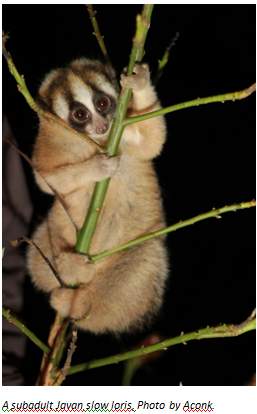
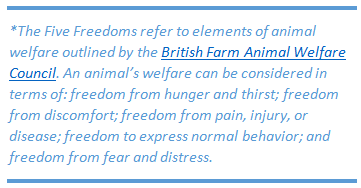
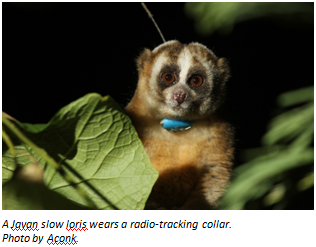
ASP: What can the average person do to help stop slow lorises from suffering in the illegal wildlife trade?
Anna: The best thing the average person can do is never to “like” or share pet loris videos, memes, or images on social media and to write polite comments asking anyone who has uploaded these images to remove them. In countries such as parts of the USA, the UK and Japan, where it is legal to keep primates as pets, one can write to his or her local politician asking to support the ban of this practice. There is no reason in this day and age to keep primates as pets.
ASP: How do conservation and welfare goals for slow lorises intersect in the activities of the LFP?
Anna: We provide data to zoos and rescue centers as to appropriate care, including dietary and housing guidelines. We have a large array of materials, including photos of wild loris habitats to help with enclosure design. We have written recommendations for release of slow lorises to the wild. We also work closely with local governments when they have a confiscation to help with the care of the animals.
ASP: The LFP does a lot of field research with slow lorises. Does observing slow loris behavior in a natural setting help you understand how to evaluate their welfare in other contexts?
Anna: We started our field study because so many animals were dying in rescue centers and dying during release. Indeed the first monitored study showed a 93% death rate of released animals. We were so surprised to learn how extremely unusual slow lorises are! They have an extremely specialized diet, are extremely social, have very long periods of infant dependence, and their dispersal patterns and territoriality were also surprising. Also, understanding the function of their venom has been vital, since all of these factors play a part in high death rates and lack of breeding in captivity.
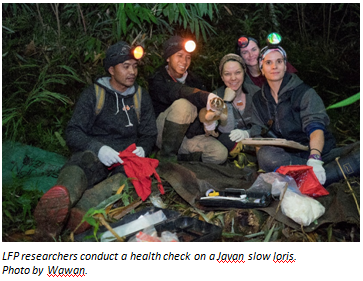
ASP: Are there certain considerations you have to keep in mind about the welfare of your study subjects in the field? How does welfare guide your decision making related to LFP research and conservation activities?
Anna: We noted early on that slow lorises under anesthesia became extremely stressed, and that due to their territoriality, it was vital they could go straight back to their home range with all senses intact. We developed novel ways to hold them and very quick ways to measure and collar them, so we can do everything as stress free as possible, without needing to anaesthetize the animals. We are very passionate about the use of red lights since these do not hurt the animals’ eyes and allow them and us to keep night vision. It also allows the animals to distinguish us from potential poachers. We are also passionate about not using blue LEDs that have been shown to degrade the retina of animals. We also keep a distance from the animals. Because the species is Critically Endangered, twice we made the decision to treat an animal that we saw was sick, and both of these animals recovered amazingly well. From a science perspective, many people would have said we should not have interfered, but with so few animals left, and so many efforts to get them back to the wild, it seemed ridiculous not to administer some simple antibiotics and antifungal treatments to wild animals that were a bit sick. Overall, we pride ourselves in training a new generation of scientists to study, observe, and care for slow lorises in the best way possible, with appropriate housing, social situations, and diet. By making as much of our information available online as possible, we hope that captive management and welfare of these amazing primates will only get better and better.
For additional information, please see the following selected references:
Cabana F, Dierenfeld E, Wirdateti W, Donati G, Nekaris KAI. 2017. Trialling nutrient recommendations for slow lorises (Nycticebus spp.) based on wild feeding ecology. Journal of Animal Physiology and Animal Nutrition 102(1):e1-e10. https://doi.org/10.1111/jpn.12694
Fuller G, Eggen WF, Wirdateti W, Nekaris KAI. 2018. Welfare impacts of the illegal wildlife trade in a cohort of confiscated greater slow lorises, Nycticebus coucang. Journal of Applied Animal Welfare Science 21(3):224-238. https://doi.org/10.1080/10888705.2017.1393338
Nekaris KAI, Musing L, Vazquez AG, Donati G. 2016. Is tickling torture? Assessing welfare towards slow lorises (Nycticebus spp.) within Web 2.0 videos. Folia Primatologica 86(6):534-551. https://doi.org/10.1159/000444231